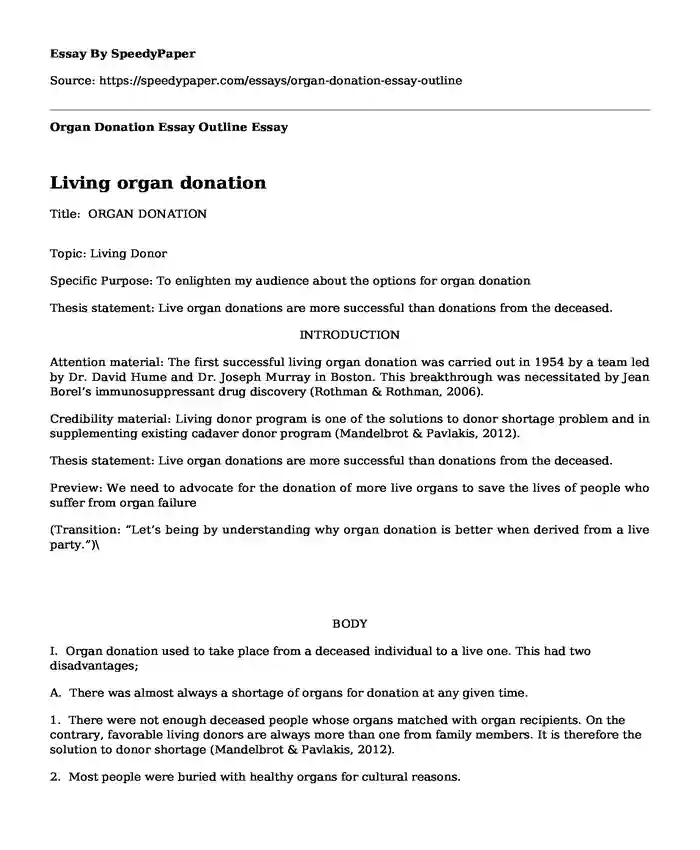Living organ donation
Title: ORGAN DONATION
Topic: Living Donor
Specific Purpose: To enlighten my audience about the options for organ donation
Thesis statement: Live organ donations are more successful than donations from the deceased.
INTRODUCTION
Attention material: The first successful living organ donation was carried out in 1954 by a team led by Dr. David Hume and Dr. Joseph Murray in Boston. This breakthrough was necessitated by Jean Borel’s immunosuppressant drug discovery (Rothman & Rothman, 2006).
Credibility material: Living donor program is one of the solutions to donor shortage problem and in supplementing existing cadaver donor program (Mandelbrot & Pavlakis, 2012).
Thesis statement: Live organ donations are more successful than donations from the deceased.
Preview: We need to advocate for the donation of more live organs to save the lives of people who suffer from organ failure
(Transition: “Let’s being by understanding why organ donation is better when derived from a live party.”)\
BODY
I. Organ donation used to take place from a deceased individual to a live one. This had two disadvantages;
A. There was almost always a shortage of organs for donation at any given time.
1. There were not enough deceased people whose organs matched with organ recipients. On the contrary, favorable living donors are always more than one from family members. It is therefore the solution to donor shortage (Mandelbrot & Pavlakis, 2012).
2. Most people were buried with healthy organs for cultural reasons.
B. The quality of organs derived from deceased individuals was poor.
1. Some organs had already began to decay and they had to be treated before being put forth for donation.
2. Most dead people had been sick for a while and therefore their organs were affected. They were not likely to perform optimally in the recipients’ bodies after transplantation.
(Transition: Now that you understand why organ donation is better when derived from a live party, let’s examine why it was not a viable option until recently.)\
II. Organ transplantation was marked by a lot of failure.
A. In the 18th century only experimental organ transplantation were carried out
B. Many failures were experienced until the mid-20th century
C. Successes began to be realized after development of immunosuppressant drugs that reduced the chances of organ rejections (Rothman & Rothman, 2006).
(Transition: Successes related with live organ donations……)
III. Policies approving live organ donation.
A. In 1983, FDA approved cyclosporine an anti-rejection medication.
B. 1n 1986, Required Request Laws was approved and hospitals were tasked with the responsibility of to making policies that would identify potential live donors and allow for family member to donate organs amongst themselves (organdonor.gov, 2016).
(Transition: “Finally, the opposition to live organ donation”)\
IV. People opposing live organ transplantation believe that;
A. The practice leads to exploitation of women, the poor and could be discriminative.
1. Pressure is mounted on mothers, sisters and wives to donate organs at the expense of their male siblings. This is considered to be unethical (The Living Bank, 2016).
2. People who cannot afford living organs do not get delayed services. Donors could select recipients in a way that is bias according to their gender, race or religion (Khedmat & Taheri, 2010).
CONCLUSION
Summary statement: Live organ donation is proven medical practice that saves lives and reduces the chances of organ rejection. Donors have the will to choose who to give their organs to and therefore there are very little or no legal complications.
Concluding remarks: All civil rights groups should first support organ live organ donation realizing its benefits then work with legal and medical practitioners to counter the negative social results of the practice.
References
Khedmat, H., & Taheri, S. (2010). Ethical disputes in living donor kidney transplantation: what should we do to save lives? Saudi Journal of Kidney Dispute Transplant, 971-974.
Mandelbrot, D. A., & Pavlakis, M. (2012). Living Donor Practices in the United States. American Journal Transplant, 212-219.
organdonor.gov. (2016, January). The Living Donation Process. Retrieved from U.S. Government Information on Organ Donation and Transplantation: http://www.organdonor.gov/about/process/living-donation.html
Rothman, M. S., & Rothman, J. D. (2006). The Hidden Cost of Organ Sale. American Journal of Transplantation, 1524-1529.
The Living Bank. (2016, February). Living Donation. Retrieved from livingbank.org: https://www.livingbank.org/living-donation
Cite this page
Organ Donation Essay Outline. (2017, Oct 20). Retrieved from https://speedypaper.net/essays/organ-donation-essay-outline
Request Removal
If you are the original author of this essay and no longer wish to have it published on the SpeedyPaper website, please click below to request its removal:
- Free Essay on Knowledge Management in Organizations
- Free Paper with Questions on Human Geography
- The Slippery Slope Fallacy, Personal Experience Essay Sample
- Cause of the Exxon Valdez Oil Spill, Free Paper Sample
- A Visit to Newgate, Essay Example for Everyone
- Challenges of Expansion to a Foreign Location
- Antitrust Case Analysis
Popular categories





